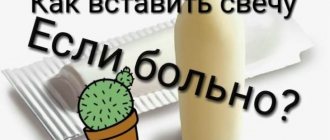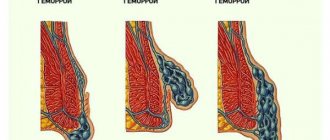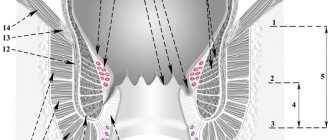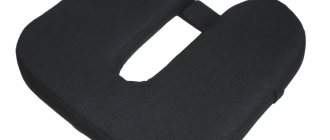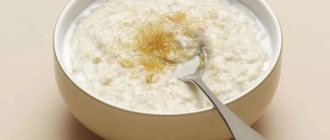The problem of hemorrhoids has been repeatedly touched upon in medical articles. For interested readers, the main and secondary causes and symptoms of this disease, as well as the treatment methods used, both conservative and surgical, were listed in detail.
At the same time, although general information is also important for understanding the nature of the disease under discussion and the approaches to its clinical therapy, patients often want answers from the proctologist to more specific questions regarding the recommended lifestyle, the advisability of following a diet, prognosis for cure, etc. In order not to Leaving aside nothing that may concern patients suffering from this delicate ailment, detailed answers to the eight most frequently asked questions about anal hemorrhoids will be given below.
Is it true that hemorrhoids are a lifelong diagnosis?
No it is not true. Hemorrhoids are indeed regarded by medicine as a recurrent disease, but this statement also has its own nuances.
In particular, sometimes the expansion of hemorrhoidal veins is caused not by external factors (weight lifting), but by internal problems with the venous system. Weakness and thinning of veins throughout the body can lead to a number of diseases, the list of which includes hemorrhoids. Completing a full course of vascular therapy will help solve this problem.
Cool baths
Procedures with cold water should take no more than 4 minutes. A shorter bath time is unlikely to have a significant therapeutic effect. A pleasant side effect will be strengthening the immune system. After all, cool temperatures help strengthen the body's defenses. When using this method, the following effects on hemorrhoid symptoms occur.
| Symptom. | Effect. |
| Pain, discomfort in the anorectal area. | There is a decrease in these manifestations due to the anesthetic effect of low temperature. |
| Burning, itching of the anus. | Cold water alone is unlikely to alleviate the condition, but adding chamomile or wormwood will have an antihistamine effect. |
| Bleeding of varicose nodes. | Blood vessels narrow, the antithrombic system is activated, which improves hemodynamics and stops bleeding. |
| Inflammation, swelling of nearby subcutaneous tissue. | By normalizing the permeability of the walls of capillaries, veins, and arteries, the output of intercellular fluid is reduced, which reduces these symptoms. |
You can use a contrast shower for exacerbation of hemorrhoids. It consists of alternating cold and warm water. At the same time, vascular tone is strengthened and corresponding manifestations are reduced. Of course, it is unlikely that hemorrhoids can be cured only by using cool baths. However, their use significantly improves the condition of patients.
What is the most effective method of surgical treatment of hemorrhoids?
This is the wrong way to pose the question because at different stages of the disease different methods of radical therapy are used.
In particular, sclerotherapy is most effective for primary hemorrhoids that are detected in the early stages. Laser vaporization is more applicable for chronic, unadvanced forms of the disease. And the removal of hemorrhoids through hemorrhoidectomy, including the radio wave method using the Surgitron apparatus, is indicated for external prolapse of the nodes in the later stages.
Urologist-andrologist, urologist of the highest category Nizamutdinov Vadim Munirovich
Methods of using baths
There are several options for taking a bath:
- Warm. Such procedures are useful for prevention of hemorrhoids and exacerbations.
- Hot. Do not use if there is bleeding.
- Cool. Such baths will relieve pain and reduce swelling of hemorrhoids.
In order for a bath to bring tangible benefits and not cause harm, the following features must be taken into account:
Relaxing treatments
- The water temperature should be no more than 36 degrees. This is optimal for reducing itching and discomfort of the anorectal area.
- You can use a variety of baths: sitz baths or rinses. To enhance the therapeutic effect, it is recommended to add decoctions of medicinal herbs: chamomile, oak bark, calendula or eucalyptus.
- Contraindications for taking baths are severe bleeding from varicose veins of the rectum.
- A small amount of water is enough to cover the buttocks.
- The most noticeable effect will be provided by sitz baths or lotions.
Patients are interested in how to properly wash themselves during an exacerbation of hemorrhoids, whether it is worth using other disinfectants, and whether this can be done often. With this disease, it is possible to add sea salt, potassium permanganate or hydrogen peroxide to the water. This will have an additional anti-inflammatory, antiseptic and anesthetic effect.
There is a technique for proper washing for hemorrhoids:
- You need to wash from the perineum to the tailbone.
- There is no need to rub in the water, it must be applied with patting movements.
- In parallel with this procedure, you can perform a light massage of the anus.
- You need to wipe by blotting with a clean napkin.
When asked by a patient whether it is worth taking a sitz bath, a regular bath, or medicinal washes, it is necessary to answer that all remedies are equally effective. They must be carried out at least twice a day.
Alcohol
Regular consumption of alcoholic beverages has a destructive effect on the body: immunity decreases, and the body’s ability to resist infections deteriorates. Alcohol disrupts the normal blood supply to the pelvic organs, leads to congestion, and worsens the metabolism of the prostate gland.
Many patients are interested in the possibility of drinking light alcohol, in particular beer. It is also not recommended to drink it constantly and during treatment. Such drinks contribute to changes in hormonal balance and reduce testosterone production. This negatively affects the health of the male gland.
Antibacterial therapy is another answer to the question of why you can’t drink if you have prostatitis. Infectious lesions are the basis for prescribing antibiotics. Almost all drugs in this group are incompatible with alcohol and cause severe adverse reactions that can pose a threat not only to the health, but also to the life of the patient. Excluding alcoholic beverages from the diet is an important factor for success in the treatment of prostatitis.
Doctors' advice when using baths
To prevent this disease, medicinal baths can be prescribed in the initial stages of hemorrhoids. Naturally, it is unlikely that the doctor will advise using only this method. Its use in complex therapy will help quickly relieve exacerbation, reduce inflammation and delay the need for surgical interventions. To achieve the best effect, it is recommended to use some rules.
These include:
At the doctor's appointment
- Before carrying out water procedures, it is necessary to carry out hygienic measures. It is unlikely that a full intestine will help reduce hemorrhoids.
- After a bath, you should not go outside for several hours; cold air can worsen the course of the disease.
- This method is not contraindicated during pregnancy or breastfeeding.
- There are no side effects or allergic reactions. It is unlikely that ordinary water will cause any side effects.
- If necessary, you can add solutions of any medicinal substances.
- You should not take a bath if bleeding begins or if hemorrhoids worsen.
Patients often ask the question whether it is possible to use laundry soap for chronic hemorrhoids, whether this will worsen the course of the disease.
There are several ways to use it in this situation:
- Place a bar of soap in hot water and vigorously dissolve it until the liquid cools.
- Grate the soap on a coarse grater and add to the bath, whisking thoroughly until foam appears.
Such baths are especially effective in the postoperative period; it is unlikely that the absence of surgery can have a similar therapeutic effect.
How to cook and take baths
The water temperature should practically coincide with body temperature; this must be resolved first. If you are going to swim in it as usual, then the only precaution is to be careful about the affected area. It is important to rinse it carefully with a soft sponge. If you use any gels or other products, be sure that you do not have any allergies to them. By the way, it is not recommended to use soap, because it can dry out the skin quite strongly, and this will lead to additional discomfort.
Both regular and sitz baths should be at body temperature
Typically, medicinal baths are done sessile, then the best effect of the procedure is achieved. To do this, you can put a basin of water in the bath and sit in it so that your legs remain outside and your knees are at the top. Warm water already in the first minutes helps relieve tension, the patient does not feel pain, the itching goes away. It also has a good effect on the skin; after several “techniques,” the swelling goes away almost completely. In addition, blood circulation is finally restored, so that the blood circulates normally without forming any stagnation.
It is recommended to organize such relaxing activities 2 times a day: in the morning and before bed. Don’t be afraid to spend time on them during your morning routine, because the procedure only takes 5 minutes, you just need to not be lazy and prepare everything.
Smoke baths
One can hardly expect a tangible effect from using this method. The principle of its action is the effect of smoke or steam on the anal area.
This smoke procedure is carried out as follows:
- Take a bucket or other similar container.
- A large flat stone or brick, heated on the stove until hot, is carefully placed at the bottom.
- You can pour any medicinal substance or herbal mixture onto it.
- They sit on the bucket so that the anus area is located directly above the stone.
- The resulting cracks are covered with a sheet or blanket.
This method must be used until the brick has completely cooled. It must be used carefully to avoid burns to the anus. It is unlikely that the patient will want to treat burns in addition to hemorrhoids.
When using such folk methods, one should not forget about consulting a doctor. Only a doctor can tell you whether it is possible to use a smoke bath, whether it is possible to bathe or wash yourself with hemorrhoids.
Is it possible to use the sauna?
Baths and saunas are controversial events in this matter. But the answer is simple: it’s not worth the risk. The fact is that due to the high temperature, the blood will, of course, begin to circulate, but not in the right way. It will create powerful inflows in the vessels, which will entail one thing: an increase in hemorrhoids and cones. After all, a hot bath for hemorrhoids is prohibited for the same reason.
There are too many external factors in saunas that negatively affect the patient’s condition
Advice: Refrain from any activities that could harm you during an exacerbation of the disease. It is very important not to irritate that same area again, especially if the nodes have fallen out. It is better to be patient a little and cure everything at the initial stage without any complications.
Inflammatory processes can also worsen if any infections occur. Therefore, it is also recommended to refrain from swimming in the sea. There are too many different microelements, including bacteria and unwanted substances. The already affected area will become even more irritated, leading to unbearable pain.
Characteristics and symptoms of hemorrhoids
Hemorrhoids are a proctological pathology, which is characterized by the appearance of blood stagnation in the cavernous plexuses of the rectum. Against this background, hemorrhoidal nodes form on the mucous membrane of the rectum and in the anus, which under certain conditions become inflamed and bleed.
The disease manifests itself with characteristic symptoms that disrupt normal life and cause anxiety and inconvenience. In the anal area there is pain, itching and burning. The process of defecation may be accompanied by pain and bleeding.
Hemorrhoids progress quickly, so it is important to carry out treatment correctly and in a timely manner. As the disease progresses, the severity and severity of symptoms increases. In addition, treatment in advanced cases turns out to be longer and more complex: often the only option is surgical treatment.
Among the various means of treating and preventing hemorrhoids, doctors do not ignore sitz baths, which are prescribed for:
- symptomatic therapy: help relieve itching, relieve pain, relieve external manifestations of inflammation;
- prevention of exacerbations;
- preparing the patient for surgery;
- accelerating recovery after surgical/hardware treatment.
Baths for hemorrhoids, as a rule, complement the course of treatment. The doctor recommends the procedure to the patient in accordance with individual indications.
Recipes for therapeutic baths
There are many options for using medicinal baths during an exacerbation of hemorrhoids, but only a few of them are most effective. For their preparation, salt solutions or potassium permanganate are used. They are carried out after careful hygiene and wiping of the anus.
With potassium permanganate
Potassium permanganate is a disinfectant, antibacterial and disinfectant.
To carry out this manipulation it is necessary:
- Empty your bowels naturally or do an enema.
- Dissolve a few grains of dry matter until a pale pink color appears.
- The procedure takes about 20 - 30 minutes.
- The temperature should not be too hot or too cold.
Before carrying out it, you need to check with your doctor whether this method can be used.
Salt baths
For these purposes, use ordinary table salt. For one bath, 200 g of the substance will be enough. It is not worth taking a larger quantity; it is unlikely to improve the therapeutic effect.
It is taken as follows:
- Dilute salt in water.
- The liquid should be no more than 36-37 degrees.
- An act of defecation or a cleansing enema is performed.
The saline solution will quickly reduce swelling and relieve inflammation of hemorrhoids and surrounding tissues. This method is unlikely to have any side effects.
Three-step algorithm for treating abdominal pain
Why painkillers don't help
Let's start with the simplest question: what should you do if discomfort appears in the abdominal area?
Of course, take a pill! For many of us, the answer is... "obvious." A person who cares “too much” about health, much less knows “more than necessary” about it, looks strange. From the point of view of many around him, he simply has nothing to do! The results are obvious: 45% of Russians, feeling pain in the stomach, grab analgesics... And only 28% take antispasmodics. Moreover, over the past six months, every sixth person felt pain in the abdominal area. Women are more often affected. Why is an analgesic dangerous for abdominal pain?
Because it will not eliminate the true cause of the unpleasant sensations, but will disguise it. Indeed, in 60% of cases the culprit of the pain syndrome is spasm.
What is a spasm?
This is an excessive contraction of smooth muscle cells in various organs. In our case we will talk about the digestive system. Inflammatory process - for example, gastritis, enteritis, colitis or ulcers, poisoning and other exposure to pathogenic microbes, a foreign body in the cavity of the digestive organ (a part from a toy in the stomach or a stone in the gall bladder), an imbalance of the substances we need - vitamins and microelements... Because of this, our organs, which are one way or another responsible for digesting food, feel uncomfortable and painfully contract. Analgesics do not act on the cause of the pain, and they will only affect the transmission of nerve impulses, and will not remove the spasm. Plus, as was said earlier, they will mask the pain - and the doctor will not understand anything. Or he will understand, but it’s too late. After all, the remaining 40% of abdominal pain - 4 cases out of 10 - are conditions in which you need to call an ambulance!
Acute pancreatitis, appendicitis, perforation of an ulcer, rupture of an aneurysm of blood vessels in the abdominal cavity, severe inflammatory diseases in women. Peritonitis is an inflammation of the peritoneum, which occurs not only when the appendix ruptures, but also when “treating” gynecological diseases through patience. A stone that has passed out of the gallbladder and blocked the bile duct. If you take an analgesic, it will be difficult for the doctor to understand where the cause of the illness is. And precious time when emergency surgery should have begun will be lost. The antispasmodic will not affect the sensations caused by acute cholecystitis, perforation of an ulcer or rupture of the appendix. The pain will not decrease.
What happens if you “treat” ordinary chronic gastritis with an analgesic?
Painkillers of this type are harmful to the gastric mucosa (and other digestive organs). If you take non-steroidal anti-inflammatory drugs for just a week, then one in five will have a stomach ulcer. And one in seventy will experience gastrointestinal bleeding. What if such patients also take analgesics to relieve pain? “Harmless and safe” drugs for pain relief have their side effects. Therefore, non-steroidal anti-inflammatory drugs and other analgesics should be taken under the supervision of a doctor! Turning them into daily medicine is dangerous. By the way, how long can you “treat yourself” with painkillers?
What to do if your stomach hurts?
In 2002, Vladimir Trofimovich Ivashkin, academician of the Russian Academy of Medical Sciences, chief gastroenterologist of Russia, director of the Clinic of Propaedeutics of Internal Diseases, Gastroenterology, Hepatology of the First Moscow State Medical University named after. THEM. Sechenov, developed a stepwise algorithm of actions for abdominal pain:
• Stage one – mild pain What to do: if necessary, take an antispasmodic. But: – if the pain occurred once, after unusual or poor-quality food, eating disorders or overeating, this is one situation. And if pain occurs with sufficient frequency, i.e. the stomach hurts sometimes or periodically, or in the morning, or after nervous stress, or even from hunger - the situation is completely different. Go to the doctor for an appointment as soon as possible!
• Stage two – the pain is quite severe and/or long-lasting. What to do: be sure to take an antispasmodic. After this, even if your stomach hurts less or the abdominal pain stops altogether, consult a doctor immediately!
• Stage three – very severe pain! Or pain that gets worse. If your stomach hurts unbearably, the cause could be those same 40% - appendicitis, rupture of the gallbladder, perforation of an ulcer, thrombosis of intestinal vessels. What to do: call an ambulance!
Five principles that are important for everyone to know
Abdominal pain is a special pain. Its nature is simply not taken into account by universal drugs for pain relief. And our compatriots, having encountered at least once a modern “optimized” clinic (according to Ministry of Health standards, there is one gastroenterologist per 70 thousand people), try to solve the problem by taking a pill. They will not be told why this is dangerous. After all, there are not enough doctors even for treatment, let alone for prevention and health schools. Therefore, the French manufacturer SANOFI organized a training program - “Pain that is dangerous to anesthetize” with the involvement of gastroenterologists in the educational project. Clinical pharmacologist, candidate of medical sciences, Alexander Maslyakov has developed another instruction for the patient - five principles of action for abdominal pain.
• Principle 1. One of the causes of abdominal pain is spasm, a contraction of the smooth muscles of the digestive organs under the influence of unfavorable factors. For this reason, medications that relieve pain are only first aid. Be sure to find out why your stomach hurts, i.e. what is the condition of the gastrointestinal tract, liver, gallbladder, pancreas and spleen.
• Principle 2. The first choice drug for abdominal pain is an antispasmodic. If you have a spasm of the smooth muscles of the stomach or intestines, you will feel less pain after taking the medicine. And in acute conditions that require urgent surgery, antispasmodics will not mask the pain, and the doctor will have time to understand what happened and how to act.
• Principle 3. For abdominal pain, analgesics are dangerous! They must not be used under any circumstances! A drug of this type will not eliminate the cause of pain - it will simply block the transmission of signals about problems in the body. The brain does not know about problems. Doctors won’t even know about them - after all, the pain sensations are masked, and it’s difficult to make a correct diagnosis.
• Principle 4. If an antispasmodic does not relieve pain within 2–3 hours, consult a doctor!
• Principle 5. If the abdominal pain is severe, if it increases or even simply does not decrease, if you have a high temperature, if your blood pressure is low, if you have nausea and/or vomiting, if you have a headache, call an ambulance immediately!
Be careful! Take care of yourself!
Link to publication: life24.ru

